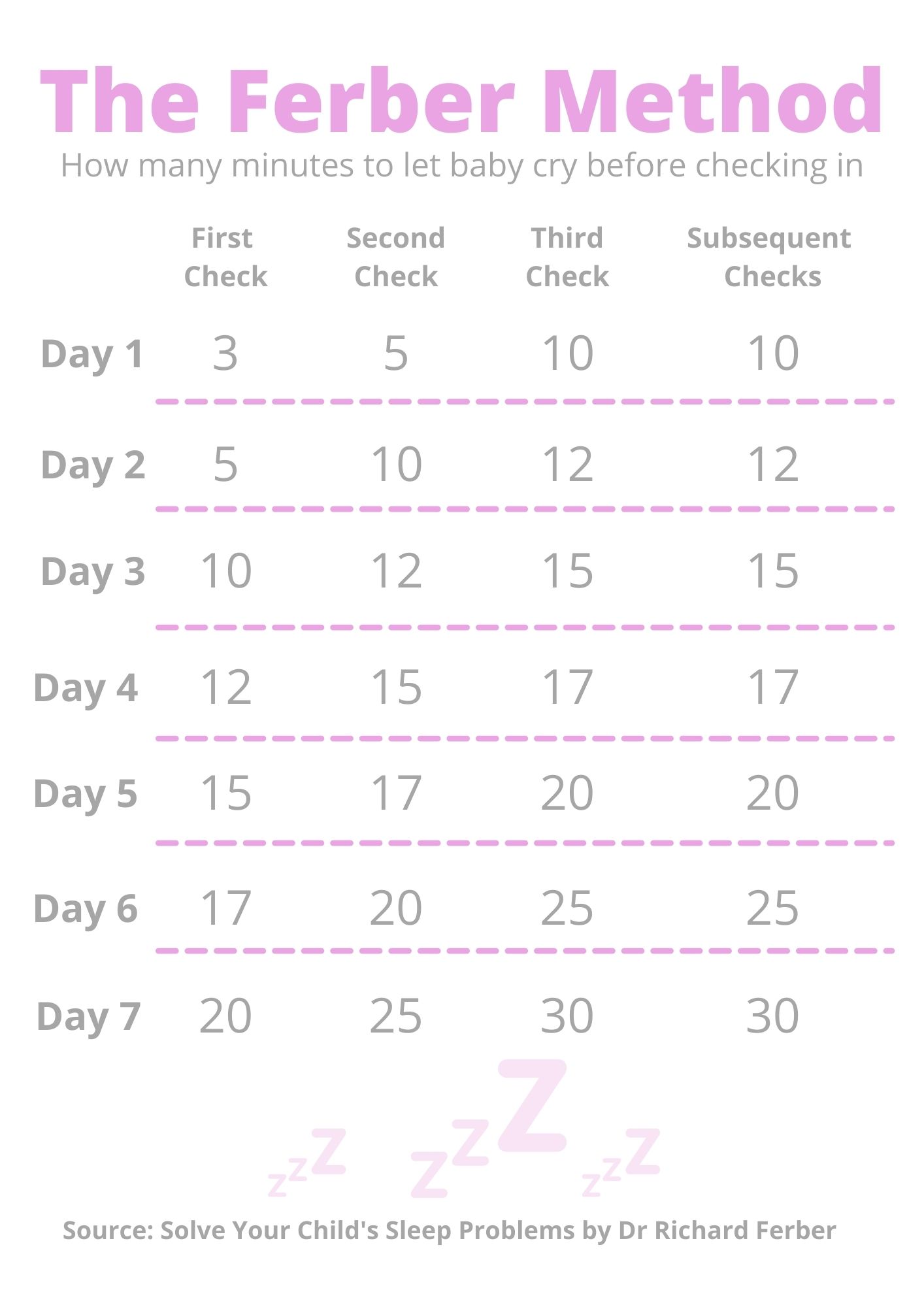Ferber Method of sleep training, what is it?
Here's everything you need to know about the sleep training technique...

The Ferber method of sleep training is periodically checking in on your crying baby at timed intervals increasing steadily, and soothing baby verbally with no feeding and no picking up.
Alongside the best baby monitors, a knowledge of baby sleep training is one of the ways to make sure you're prepared for teaching your baby to wind down for the night, self-regulate, and eventually fall asleep - meaning hopefully you can get some much-deserved shut-eye too, sometimes choosing from one of the best swaddles can help. The Ferber Method is one of the popular sleep training techniques, and claims to help babies learn to self-sooth; to ultimately fall asleep on their own, and to fall back to sleep with minimal interaction when they wake in the night.
When your baby goes through one of the sleep regression ages, sleep training can help with this too. Sleep consultant Sarah Patel tells us; "I don't judge any parent for sleep training. I did it with my daughter in pure desperation, parenting is hard enough without judgment. My advice, do what feels right to you, research shows that a parent’s instinct is usually the most accurate." And the best thing a parent can have in their arsenal is knowledge. So, here’s how the Ferber Method works and exactly how it can help your baby get the hang of falling asleep solo, sooner.
What is the Ferber Method?
The Ferber Method involves periodically checking in on your baby when they're in their crib and crying, as a way of getting your baby to sleep. And studies show that sleep training actually improves baby sleep.
According to this range of reports, some parents who sleep train with the cry it out method can find it stressful as they don't go back into their baby’s room at all, even if the baby cries for a long time. The Ferber method is considered to be a gentler option. And it aims to teach your child to enjoy the bedtime routine, fall asleep quickly and easily, self-soothe when they wake in the night, sleep peacefully through the night and embrace daytime naps.
The periodic check-ins mean that you’ll go to your baby at timed intervals. These intervals gradually get longer until they fall asleep. The check-ins also get longer on subsequent nights. Dr Richard Ferber, who has been researching infant sleep for the past 30 years, calls it the "progressive waiting approach."

You can soothe your baby verbally or give her a gentle rub or pat. But you shouldn’t pick her up or feed her, and your visits should only last a minute or two. Before you embark on 'Ferberizing' it's important to be honest about your comfort level with crying. Some babies fuss a little while others scream a lot.
Parenting advice, hot topics, best buys and family finance tips delivered straight to your inbox.
The Ferber method, or 'Ferberizing' your child is, in basic terms, to reassure them that you are always there, but it’s time to sleep. Many studies show that night time or sleep training works. producing reliable and durable changes in a child's sleeping habits.
While many think they are one and the same, the Ferber method of sleep training differs from the controlled crying method. While it seems to be similar, controlled crying requires leaving your baby to cry for short periods of time before offering them comfort.
As sleep training methods go, the Ferber method is divisive among the baby sleep experts. Sarah Patel, founder of Teach To Sleep, a certified baby and toddler sleep consultant, former teacher and mom of two little ones told us; 'When it comes to any form of cry it out methods, remember that it's not something you have to do. There is a growing number of gentle sleep consultants like myself who use responsive methods.
Ferber Method: The pros and cons
PROS
- It works fast, sometimes with visible improvements within a week
- Your baby will deal with separation better, for example, if they stay at a relative's house for the night.
- It's less extreme than the CIO method.
CONS
- There's no two ways round it, it really is emotionally tough to do as a parent. Hearing your baby crying, instinctively you want to hold them.
- Some research suggests crying for long periods could cause emotional distress to the child, although other studies disagree.
Your child's sleep is important, but so is yours. Don’t forget to look after yourself. Dr Dawn Harper, GP recommends napping when you can: “As a new mom, you are unlikely to get a full night’s sleep so you need to take sleep where you can. It’s the one time I think it’s appropriate to take a nap where possible! If you have a partner who is around, ask them to look after the baby. Even just for 20 or 30 minutes so that you can recharge your batteries.”
Studies show that bedtime problems and night wakings in children are common. And that a lot of parents choose to sleep train as sleep is so important for development. In addition recent reports show that many children aren't sleeping the recommended amount.
Ferber Method: How does it work?
By leaving your child - even when crying - so they have the time to learn self-soothing. The Ferber method is long-standing, it claims to support your child as they learn this new self-soothing skill. Just like they will stumble before walking on their own. By allowing your baby time to self-soothe, Dr Robert Ferber claims, that this method breaks your baby of their habit of needing you to sleep.
Similar to the Ferber method, the NHS also recommends that you establish a baby bedtime routine, such as dimmed lights and reading a story. Add some helpful Baby sleep aides to a good routine and you might be on your way to getting some shut-eye.
Here's what the Ferber method looks like in six steps;
- Ensure your bedtime routine ends with a consistent phrase or song i.e. 'It's time for sleep' or 'I love you and will see you in the morning'
- Lay your baby or toddler down drowsy but awake
- Leave the room (or sit in a chair if you prefer to try to stay in the room)
- If your child starts to cry, start your timer. If your child is not crying, no need to start the timer
- Once the timer goes off, go check-in and offer comfort. Be sure to stop soothing and/or leave while your child is still awake
- Repeat the check-in and comfort process with the different intervals (shown below) until your they fall asleep
While this sleep training method is divisive, Lucy Shrimpton, Sleep Nanny and expert panellist at The Baby Show says: "[choosing sleep training] depends on the individual set of circumstances. It also depends on the interpretation of it. There's no good or bad methods, it's about how they are customized to meet the unique needs of each family. The Ferber method could be ideal for one family and atrocious for another family. That's why having a professional sleep expert to assess case by case is so important.'
What is the Ferber Method chart?
The Ferber method chart is a helpful medium which shows the intervals to use when Ferberizing your baby. The book suggests starting with intervals at 3 minutes, 5 minutes, then 10 minutes. And, each day/night you are supposed to increase each of those intervals by 3-5 minutes as shown below.

Day 1
First check-in: 3 minutes Second check-in: 5 minutes Third check-in: 10 minutes Subsequent check-ins: 10 minutes
Day 2
First check-in: 5 minutes Second check-in: 10 minutes Third check-in: 12 minutes Subsequent check-ins: 12 minutes
Day 3
First check-in: 10 minutes Second check-in: 12 minutes Third check-in: 15 minutes Subsequent check-ins: 15 minutes
Day 4
First check-in: 12 minutes Second check-in: 15 minutes Third check-in: 17 minutes Subsequent check-ins: 17 minutes
Day 5
First check-in: 15 minutes Second check-in: 17 minutes Third check-in: 20 minutes Subsequent check-in after: 20 minutes
Day 6
First check-in: 17 minutes Second check-in: 20 minutes Third check-in: 25 minutes Subsequent check-ins: 25 minutes
Day 7
First check-in: 20 minutes Second check-in: 25 minutes Third check-in: 30 minutes Subsequent check-ins: 30 minutes
What age is appropriate for the Ferber Method?
Ideally over 6 months old. Younger babies need to feed, sometimes in the middle of the night, and their sleep-wake patterns are yet to develop. Though, studies show that it's in your baby’s best interests to sleep through the night without interruptions. As soon as they are going longer without feeds is when you can implement sleep training. Since all babies are different, this is usually around 5-6 months of age.
Things to do before you try the Ferber method;
- Ensure your baby isn't sick or teething
- Optimize your baby’s schedule
- Develop consistent bedtime and naptime routines
- Set the stage to Ferberize
- Get support during Ferberization
How long does the Ferber Method take?
On average about four nights. Though, know that there will be a lot of crying. Most babies will cry for an hour or less but some might cry for longer periods (1-2 hours) for the first two to three nights. Many people will start to see progress within 3-4 nights though that doesn’t mean you will be “done.” Dr Robert Ferber recommends implementing this method for at least 1-2 weeks. It can take time create new habits and there are many external variables to affect baby's sleep.
If you’ve been sleep training for more than two weeks, that would be cause for us to look into other reasons your baby is crying for long periods of time. Keep in mind that some babies will continue to cry for a few minutes (5-10 at the most) long-term. Anything more than that, and I’d say it isn’t working.
Is the Ferber Method cruel?
The answer to this is subjective. When exposing your baby to the Ferber method you may notice that they become much more distressed during training than they may gave been before. Pediatric sleep expert Dr Richard Ferber, author of Solve Your Child's Sleep Problems refers to these as “extinction bursts” - which include more frequent and intense crying and tantrums - can persuade some parents to give up.

While considered quite divisive, many parents rave about the Ferber method of sleep training. Hence they 'ferberize' their babies, celebrating its life-changing impact and how effective it is at teaching children how to sleep by themselves.
Like it’s similar counterpart controlled crying, the Ferber method of sleep training is sometimes frowned upon and seen as creating emotional distance between parent and child.
When to stop the Ferber Method
If after one week your baby hasn't made progress or it seems like they're still crying a lot, it might be time to take a break. You could try the Ferber method again a little later on, or research and try another sleep training approach. It's all to play for. At the end of the day it's your baby and while it might not feel like it, you do know best.
Is the Ferber method different to Cry It Out?
Essentially, yes. The Cry It Out method - also sometimes referred to as the CIO or the Extinction method - is considered more extreme than the Ferber method.
With the Ferber method you periodically go and check on your child at specific times. Whereas the Cry It Out method sees you putting your baby to bed and leaving them to cry it out until they go to sleep. It is considered a controversial method, however, there are those who find it a great success.
Related features:
- 4 month sleep regression - signs, solutions and how long it lasts
- 8-month sleep regression causes, signs - and how I survived it with my son
- 10-month sleep regression causes, signs - and how I survived it
Video of the Week
Stephanie has been a journalist since 2008, she is a true dynamo in the world of women's lifestyle and family content. From child development and psychology to delicious recipes, interior inspiration, and fun-packed kids' activities, she covers it all with flair. Whether it's the emotional journey of matrescence, the mental juggling act of being the default parent, or breaking the cycle of parenting patterns, Stephanie knows it inside out backed by her studies in child psychology. Stephanie lives in Kent with her husband and son, Ted. Just keeping on top of school emails/fundraisers/non-uniform days/packed lunches is her second full-time job.